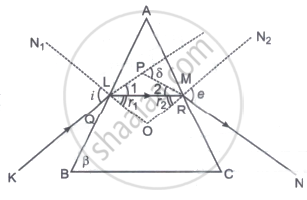Advertisements
Advertisements
Question
Prove that in case of a prism, i + e = A + δ, where the symbols have their usual meanings.
Solution
ΔABC is a principal section of the prism. A ray of light KL is incident on the face AB of the prism and the refracted ray LM is incident at r2 on the face AC of the prism. The angle of deviation is δ.
In ΔPLM,
δ = 1 + 2 ...(i)
i = 1 + r1 ...(ii)
e = 2 + r2 ...(iii)

On adding equation (ii) and (iii), we get
or i + e = 1 + 2 + r1 + r2
i + e = δ + r1 + r2 ...[from eq. (i)] ...(iv)
Again A + `angle"LOM" = angle 180^circ` [opposite angles of a cyclic quadrilateral] ...(v)
and r1 + r2 + ∠LOM = 180° ...(vi)
From equations (v) and (vi),
A + ∠LOM = r1 + r2 + ∠LOM
or A = r1 + r2 ...(vii)
Putting this value in (iv), we get
i + e = δ + A
which is the required relation.
